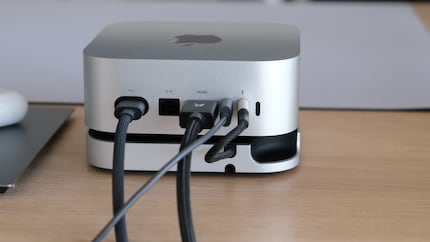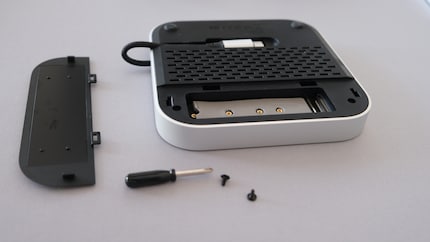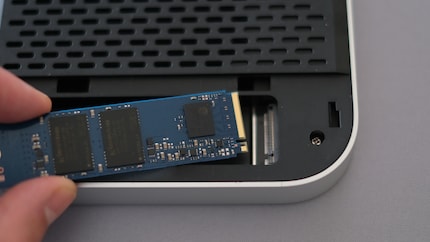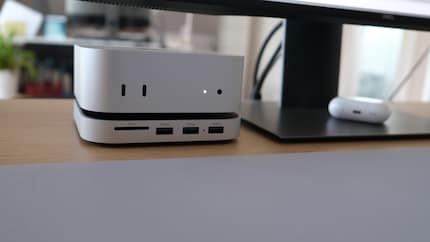
Product test
The basketball SSD tested: Lacie Rugged Mini
by Kevin Hofer

If you find the Mac Mini M4’s power button annoying, this is the solution you’ve been waiting for. The Satechi Stand + Hub serves as a mini pedestal for Apple’s latest computer. But that’s not its only plus point.
What could make «Apple’s best deal ever» (as described by my colleague Samuel Buchmann in his review) even better? If you ask me, it’s the Mac Mini M4 Stand + Hub from Satechi, a California-based company.
Though I already had a Satechi stand for my old Mac Mini M2, I made do without it for a few weeks after upgrading my Mac Mini. But it wasn’t easy. You see, Satechi hones in on what the Mac Mini is lacking, then presents you with the solution.
Apple is notorious for charging big bucks for additional storage. Upgrading the 256 GB version of the Mac Mini M4’s hard disk to a 512 GB version, for instance, will currently set you back 200 francs. To go up to a terabyte, it’ll cost you 400 francs.
By comparison, a 1 TB M.2 SSD costs just over 50 francs, while the 2 TB version is priced at about 100 francs. Apple charges an extra 800 francs for a 2 TB hard disk in the Mac Mini. Anyone willing to fork out that much more cash without complaint would have to be a massive fan of the brand.
I, on the other hand, fired up my savings calculator. The standard version of the Mac Mini 2024, with a 256 GB hard disk, currently costs around 600 francs. Meanwhile, the Satechi Hub costs 120 francs. A 1 TB plug-in SSD costs 50 francs, making a not-too-shabby 770 francs in total. The Mac Mini M4 with a 1 TB hard disk, by contrast, costs 1,100 francs. With me so far?
Satechi warns on its own website that its product is «incompatible with SATA M.2 SSDs». Turns out, the company isn’t just saying that for kicks. I experienced it myself when the SSD I’d previously used in the Satechi Hub for my Mac Mini M2 refused to work in the new Hub. It wasn’t displayed in the finder.
Only newer NVMe SSDs are compatible. I guess these also move data back and forth much faster than the old SATA models. In case you’re wondering, my SSD of choice is this one; it’s cheap and fast enough for my purposes.
Either way, the Hub sets the data transfer limit: 10 Gbps, i.e. a maximum of 1,250 MB/s. Incidentally, you could go a step further than me and use an SSD with a maximum of four TB.
If being able to move data back and forth faster is a big deal to you, you should look into getting an external SSD instead of the Satechi Hub. These can be connected directly to one of the Mac Mini M4’s Thunderbolt ports.
It’s difficult to make definitive arguments about the look of the Hub because people’s tastes and needs vary too much. For me, the Hub is a necessary evil. It doesn’t look so bad that I wouldn’t be able to cope with seeing it on my desk in the half-shadow of my monitor. Feel free to let me know what you think of it in the comments, though.
These days, the momentum is clearly with USB-C. Ever since the EU enforced USB-C as the new standard, I’ve gradually been parting with gadgets that have older cables. Even so, some gadgets still have a USB-A connection, for example external hard disks.
You wouldn’t need the Satechi Hub’s high-powered USB-A ports (3.2 Gen 2) for one of those. Even so, it’s reassuring to know that two of the three ports run at 10 Gbps. The third is «only» USB 2.0. It’s also worth mentioning that the USB-A ports won’t charge your devices; they’re purely data interfaces. If you still use an Apple SuperDrive and want to connect it, that won’t work either.
The thing I missed most during my time without the Satechi Hub was an SD card reader. Of course, I still managed to transfer my photos from my camera to the Mac Mini. I bought a memory card reader from UGreen for the relatively painless sum of 14 francs.
However, since the Satechi Hub has an SD card slot, there’s no need for a cable. Plus, I like my desk to be as tidy as possible. The speedy SD card device can read up to 312 MB per second, so my patience isn’t exactly worn thin when I’m importing video.
Side note: Satechi has changed the way cards are inserted. Rather than turning SD cards over before you slot them in, you do it so that the label is facing upwards. The thing is, they’re quite difficult to fit into the slot. At first, I was actually worried that I had the wrong SD, as it was really tight and scraping at the edges.
Are you one of those people who feels compelled to hit an Off button once you’ve finished working? If so, the new Mac Mini will definitely have bugged you. Why? Because Apple’s engineers positioned the physical power button in the dumbest place imaginable: on the bottom. As a result, you always have to lift the Mac Mini to reach the button.
The Satechi Hub solves this problem. It has a notch on one corner, just big enough for a finger to press the button on the Mac Mini.
Satechi even bigs up the feature on its packaging. However, if accessing the Mac Mini’s power button is your main problem, there are other solutions, including mounts for under your desk. 3D printing opens up all sorts of avenues in this scenario too, as demonstrated by creative people on platforms such as Etsy.
The Satechi Hub offers good solutions to two problems. First of all, it makes the power button on the Mac Mini M4 usable. Secondly – and in my case, more importantly – it opens the door to significantly cheaper SSD expansions than you’d get from Apple. Even taking the cost of buying the Satechi hub into account, you’ll still save money if you go for a 1 TB SSD. The USB-A ports are only useful to a limited extent because you can’t use them to charge your gadgets. That said, it’s better than having none, which is what you get with the Mac Mini on its own.
All in all, the Satechi Hub isn’t your best bet for SD cards or fast storage. It’s basically a Swiss Army knife for Mac Mini users: life with the Hub is better than one without.
Pro
Contra
Journalist since 1997. Stopovers in Franconia (or the Franken region), Lake Constance, Obwalden, Nidwalden and Zurich. Father since 2014. Expert in editorial organisation and motivation. Focus on sustainability, home office tools, beautiful things for the home, creative toys and sports equipment.



Of course, the Satechi Hub has some aesthetic disadvantages. The USB-A ports at the front look like the smile of a toothless uncle. Don’t you think the two USB-C ports on the Mac Mini combined with the Satechi Hub’s SSD slot almost look like a face? There’s a surprisingly large gap (measuring just under six millimetres) between the Hub and the Mac Mini. Although I’d have preferred the setup to be more compact, the space is needed so that air can circulate for cooling. However, this does have a negative impact on stability. When you’re connecting or disconnecting cables, the Mac Mini and Hub move super easily despite the rubber feet on the bottom. Overall, the build quality looks a tad cheap because of how prominently plastic features in the design.

